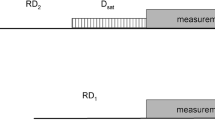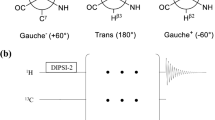Abstract
We present new NMR methods to measure slow translational diffusion coefficients of biomolecules. Like the heteronuclear stimulated echo experiment (XSTE), these new methods rely on the storage of information about spatial localization during the diffusion delay as longitudinal polarization of nuclei with long T1 such as nitrogen-15. The new BEST-XSTE sequence combines features of Band-selective Excitation Short-Transient (BEST) and XSTE methods. By avoiding the saturation of all protons except those of amide groups, one can increase the sensitivity by 45% in small proteins. The new experiment which combines band-Selective Optimized Flip-Angle Short-Transient with XSTE (SOFAST-XSTE) offers an alternative when very short recovery delays are desired. A modification of the HSQC-edited version of the XSTE experiment offers enhanced sensitivity and access to higher resolution in the indirect dimension. These new methods have been applied to detect changes in diffusion coefficients due to dimerization or proteolysis of Engrailed 2, a partially disordered protein.






Similar content being viewed by others
References
Ahuja P, Sarkar R, Vasos PR, Bodenhausen G (2009) Diffusion coefficients of biomolecules using long-lived spin states. J Am Chem Soc 131:7498–7499. doi:10.1021/ja902030k
Altieri AS, Hinton DP, Byrd RA (1995) Association of biomolecular systems via pulsed field gradient NMR self-diffusion measurements. J Am Chem Soc 117:7566–7567. doi:10.1021/ja00133a03
Augé S, Schmit PO, Crutchfield CA, Islam MT, Harris DJ, Durand E, Clemancey M, Quoineaud AA, Lancelin JM, Prigent Y, Taulelle F, Delsuc MA (2009) NMR measure of translational diffusion and fractal dimension. Application to molecular mass measurement. J Phys Chem B 113:1914–1918. doi:10.1021/jp8094424
Augustyniak R, Balayssac S, Ferrage F, Bodenhausen G, Lequin O (2011) 1H, 13C and 15N resonance assignment of a 114-residue fragment of Engrailed 2 homeoprotein, a partially disordered protein. Biomol NMR Assign. doi: 10.1007/s12104-011-9306-5
Bernado P, Blackledge M (2009) A self-consistent description of the conformational behavior of chemically denatured proteins from NMR and small angle scattering. Biophys J 97:2839–2845. doi:10.1016/j.bpj.2009.08.044
Brand T, Cabrita E, Morris GA, Gunther R, Hofmann H, Berger S (2007) Residue-specific NH exchange rates studied by NMR diffusion experiments. J Magn Reson 187:97–104. doi:10.1016/j.jmr.2007.03.021
Brown WE, Wold F (1973) Alkyl isocyanates as active-site-specific reagents for serine proteases. Reaction properties. Biochemistry 12:828–834. doi:10.1021/bi00729a007
Buevich AV, Baum J (2002) Residue-specific real-time NMR diffusion experiments define the association states of proteins during folding. J Am Chem Soc 124:7156–7162. doi:10.1021/ja012699u
Cantor CR, Schimmel PR (1980) Biophysical chemistry, part II: techniques for the study of Biological Structure and Function. W.H. Freeman, San Francisco
Carravetta M, Johannessen OG, Levitt MH (2004) Beyond the T1 limit: singlet nuclear spin states in low magnetic fields. Phys Rev Lett 92:153003–153004. doi:10.1103/PhysRevLett.92.153003
Cavadini S, Vasos P (2008) Singlet states open the way to longer time-scales in the measurement of diffusion by NMR spectroscopy. Concepts Magn Reson 32A:68–78. doi:10.1002/cmr.a.20100
Cavadini S, Dittmer J, Antonijevic S, Bodenhausen G (2005) Slow diffusion by singlet state NMR spectroscopy. J Am Chem Soc 127:15744–15748. doi:10.1021/ja052897b
Chang PT (2000) Chapter 21.4 diffusion. In: Physical chemistry for the chemical and biological sciences, 2nd edn, University Science Books, Sausalito, CA, pp 876–883
Choy WY, Mulder FAA, Crowhurst KA, Muhandiram DR, Millett IS, Doniach S, Forman-Kay JD, Kay LE (2002) Distribution of molecular size within an unfolded state ensemble using small-angle X-ray scattering and pulse field gradient NMR techniques. J Mol Biol 316:101–112. doi:10.1006/jmbi.2001.5328
Connell MA, Bowyer PJ, Bone PA, Davis AL, Swanson AG, Nilsson M, Morris GA (2009) Improving the accuracy of pulsed field gradient NMR diffusion experiments: Correction for gradient non-uniformity. J Magn Reson 198:121–131. doi:10.1016/j.jmr.2009.01.025
Danielsson J, Jarvet J, Damberg P, Graslund A (2002) Translational diffusion measured by PFG-NMR on full length and fragments of the Alzheimer Aβ(1–40) peptide. Determination of hydrodynamic radii of random coil peptides of varying length. Magn Reson Chem 40:S89–S97. doi:10.1002/mrc.1132
Danielsson J, Liljedahl L, Barany-Wallje E, Sønderby P, Kristensen LH, Martinez-Yamout MA, Dyson HJ, Wright PE, Poulsen FM, Maler L, Graslund A, Kragelund BB (2008) The intrinsically disordered RNR inhibitor Sml1 is a dynamic dimer. Biochemistry 47:13428–13437. doi:10.1021/bi801040b
Delaglio F, Grzesiek S, Vuister GW, Zhu G, Pfeifer J, Bax A (1995) NMRPipe: a multidimensional spectral processing system based on UNIX pipes. J Biomol NMR 6:277–293. doi:10.1007/BF00197809
Dyson HJ, Wright PE (2005) Intrinsically unstructured proteins and their functions. Nat Rev Mol Cell Biol 6:197–208. doi:10.1038/nrm1589
Ferrage F, Zoonens M, Warschawski DE, Popot J-L, Bodenhausen G (2003) Slow diffusion of macromolecular assemblies by a new pulsed field gradient NMR method. J Am Chem Soc 125:2541–2545. doi:10.1021/ja0211407
Ferrage F, Zoonens M, Warschawski DE, Popot J-L, Bodenhausen G (2004) Slow diffusion of macromolecular assemblies measured by a new pulsed field gradient NMR method. J Am Chem Soc 126:5654. doi:10.1021/ja033464g
Fraenkel E, Rould MA, Chambers KA, Pabo CO (1998) Engrailed homeodomain-DNA complex at 2.2 Å resolution: a detailed view of the interface and comparison with other engrailed structures. J Mol Biol 284:351–361. doi:10.1006/jmbi.1998.2147
Geen H, Freeman R (1991) Band-selective radiofrequency pulses. J Magn Reson 93:93–141. doi:10.1016/0022-2364(91)90034-Q
Grzesiek S, Bax A (1993) The importance of not saturating water in protein NMR. Application to sensitivity enhancement and NOE measurements. J Am Chem Soc 115:12593–12594. doi:10.1021/ja00079a052
Hahn EL (1950) Spin echoes. Phys Rev 80:580–594. doi:10.1103/PhysRev.80.580
Hsu S-TD, Fucini P, Cabrita LD, Launay H, Dobson CM, Christodoulou J (2007) Structure and dynamics of a ribosome-bound nascent chain by NMR spectroscopy. Proc Natl Acad Sci USA 104:16516–16521. doi:10.1073/pnas.0704664104
Jerschow A (2000) Thermal convection currents in NMR: flow profiles and implications for coherence pathway selection. J Magn Reson 145:125–131. doi:10.1006/jmre.2000.2083
Jerschow A, Müller N (1997) Suppression of convection artifacts in stimulated-echo diffusion experiments. Double-stimulated-echo experiments. J Magn Reson 125:372–375. doi:10.1006/jmre.1997.1123
Jerschow A, Müller N (1998) Diffusion-separated nuclear magnetic resonance spectroscopy of polymer mixtures. Macromolecules 31:6573–6578. doi:10.1021/ma9801772
Johnson CS (1999) Diffusion ordered nuclear magnetic resonance spectroscopy: principles and applications. Prog NMR Spectrosc 34:203–256. doi:10.1016/j.ab.2007.04.025
Klein-Seetharaman J, Oikawa M, Wirmer J, Duchardt E, Ueda T, Imoto T, Smith LJ, Dobson C, Schwalbe H (2002) Long-range interactions within a non-native protein. Science 295:1719–1722. doi:10.1126/science.1067680
Kupce E, Freeman R (1994) Wideband excitation with polychromatic pulses. J Magn Reson A 108:268–273. doi:10.1006/jmra.1994.1123
Li Y, Kim S, Brodsky B, Baum J (2005) Identification of partially disordered peptide intermediates through residue-specific NMR diffusion measurements. J Am Chem Soc 127:10490–10491. doi:10.1021/ja052801d
Li C, Wang Y, Pielak GJ (2009) Translational and rotational diffusion of a small globular protein under crowded conditions. J Phys Chem B 113:13390–13392. doi:10.1021/jp907744m
Martinez-Viviente E, Pregosin PS (2003) Low temperature H-1-, F-19-, and P-31-PGSE diffusion measurements. Applications to cationic alcohol complexes. Helv Chim Acta 86:2364–2378
McLachlan A, Richards J, Bilia A, Morris GA (2009) Constant time gradient HSQC-iDOSY: practical aspects. Magn Reson Chem 47:1081–1085. doi:10.1002/mrc.2518
Orekhov VY, Korzhnev DM, Pervushin KV, Hoffman E, Arseniev AS (1999) Sampling of protein dynamics in nanosecond time scale by 15 N NMR relaxation and self-diffusion measurements. J Biomol Struct Dynam 17:157–174
Pervushin K, Vögeli B, Eletsky A (2002) Longitudinal 1H relaxation optimization in TROSY NMR spectroscopy. J Am Chem Soc 124:12898–12902. doi:10.1021/ja027149q
Piotto M, Saudek V, Sklenar V (1992) Gradient-tailored excitation for single-quantum NMR spectoscopy of aqueous solutions. J Biomol NMR 2:661–665. doi:10.1007/bf02192855
Price WS (1998) Pulsed-field gradient nuclear magnetic resonance as tool for studying translational diffusion: part II. Experimental aspects. Concepts Magn Reson 10:197–237. doi:10.1002/(SICI)1099-0534(1998)10:4<197::AID-CMR1>3.0.CO;2-S
Sarkar R, Ahuja P, Vasos PR, Bodenhausen G (2008a) Measurement of slow diffusion coefficients of molecules with arbitrary scalar couplings via long-lived spin states. ChemPhysChem 9:2414–2419. doi:10.1002/cphc.200800476
Sarkar R, Moskau D, Ferrage F, Vasos PR, Bodenhausen G (2008b) Single or triple gradients? J Magn Reson 193:110–118. doi:10.1016/j.jmr.2008.04.029
Schanda P, Brutscher B (2005) Very fast two-dimensional NMR spectroscopy for real-time investigation of dynamic events in proteins on the time scale of seconds. J Am Chem Soc 127:8014–8015. doi:10.1021/ja051306e
Schanda P, Van Melckebeke H, Brutscher B (2006) Speeding up three-dimensional protein NMR experiments to a few minutes. J Am Chem Soc 128:9042–9043. doi:10.1021/ja062025p
Stejskal EO, Tanner JE (1965) Spin diffusion measurements: spin echoes in the presence of a time-dependent field gradient. J Chem Phys 42:288–292. doi:10.1063/1.1695690
Acknowledgements
Gilles Clodic and Gérard Bolbach are acknowledged for MALDI-TOF spectra acquisition and analysis. We thank Pau Bernado (IRB, Barcelona) and Damien Baigl (Ecole Normale Supérieure, Paris) for fruitful discussions.
Author information
Authors and Affiliations
Corresponding author
Electronic supplementary material
Below is the link to the electronic supplementary material.
Rights and permissions
About this article
Cite this article
Augustyniak, R., Ferrage, F., Paquin, R. et al. Methods to determine slow diffusion coefficients of biomolecules. Applications to Engrailed 2, a partially disordered protein. J Biomol NMR 50, 209–218 (2011). https://doi.org/10.1007/s10858-011-9510-8
Received:
Accepted:
Published:
Issue Date:
DOI: https://doi.org/10.1007/s10858-011-9510-8




